Heading out the door? Read this article on the new Outside+ app available now on iOS devices for members! Download the app.
Imagine wading through a river choked with mud and fallen branches. For many of us, this is how reaching toward our life goals can feel. We get blocked— by dead-end career paths, robotic daily routines, or too much drama in our relationships—and feel stranded, without the momentum to make change. That’s because we can’t flow toward the life we want until the debris is cleared. To demolish that dam you need creativity, the power to turn dormant, dusty thoughts and dreams into actions and realities, and to find clever solutions to relationship, work, and other life challenges.
So how do you tap into that truly transformative, but often elusive, energy of creativity? Via the chakras, first mentioned thousands of years ago in sacred Hindu texts called the Upanishads. Described as interconnected nodes within the subtle-energy body, the chakras run along your spine and essentially map to your endocrine and hormonal systems. It’s the second chakra, svadisthana chakra, that holds the key to unlocking and harnessing the energy you need to be innovative and to make change.
Energetically, the second chakra rules creativity, emotions, joy, enthusiasm, and sensuality. Physically, it’s located near your sacrum and hips, below your navel, and is said to be the seat of your reproductive organs. When svadisthana energy is in balance—not too intense and not too laid-back—you can access feelings of abundance, joy, and pleasure, and clear the way for creative energy to flow freely.
However, when svadisthana is blocked, by emotional trauma or chronic stress, for example, you are unable to connect with your passions. You also tend to try to control everything, and your life might lack zest. In addition to feeling like you’re in a rut, you might be unable to connect intimately or embrace deep self-love, explains Christiane Northrup, MD, a board-certified OB/GYN and author of Women’s Bodies, Women’s Wisdom, a woman-centered book about the unity of mind, body, emotions, and spirit. Physically, the body can manifest these shackled emotions as unexplained lower-back pain, tight hips, sexual-organ dysfunction, and reproductive challenges.
Unfortunately, our modern, predominantly desk- and car-bound lives can exacerbate imbalance in the second chakra. We sit more, and for longer periods, than ever, resulting in restricted (and sometimes weakened) hips that inhibit the second chakra’s creative energies. To that end, one of the most accessible ways to undo these restrictions and find second-chakra balance is through asana. Yoga’s physical postures allow prana (or life-giving breath) to flow, activating and directing energy appropriately, according to yogic philosophy.
“A hip-focused yoga practice can release discomfort and help you look at everything as an opportunity,” says Mary Beth LaRue, a Los Angeles–based yoga teacher and co-founder of Rock Your Bliss, a yoga-inspired coaching business that helps people craft creative lives. “Ultimately, hip-opening asanas teach you to loosen your grip on life and let things ebb and flow. And finding a sense of fluidity in your day-to-day life transforms all of your relationships, including your relationship with yourself.”
Keep It Contained
While most of us suffer from tight hips, it’s not unheard of to have hips that are too loose. To harness the second chakra’s power, you need both physical openness to unlock creativity, and structure to give that creativity direction. How you feel in your hips is a good indication of how balanced your second chakra is: Expansive freedom of movement (think knees all the way to the floor in Supta Baddha Konasana [Reclining Bound Angle Pose]) can signal that svadisthana energy is unbridled and overly wild. In this case, you may notice that you’re addicted to turbulent and unhealthy relationships, or experience jealousy, emotional outbursts, and unfulfilling, confusing lust. To counter this energy, add more poses like Low Lunge, with an emphasis on drawing in, containing, and stabilizing the hips. Focus on grounding with each inhale, engaging your abductors (outer-thigh muscles), hugging in toward your midline with your adductors (inner-thigh muscles), and lifting your pelvic floor to support the lower back. This will give the second chakra a clear, constructive way to express your true self, explains LaRue.
11 Poses for Opening Up to Possibility
Try this hip-opening sequence, designed to help you spark svadisthana and tap into your creative potential. “If your second chakra is balanced, it is much easier to go into the world and create the life of your dreams,” says Northrup.
When the second chakra is balanced, you can meet challenges with curiosity and playfulness, rather than letting your emotions carry you away or, alternatively, experiencing a knee-jerk reaction of shutting down or becoming defensive. Because most of us suffer from tight hips, this practice focuses on opening the physical seat of the second chakra. LaRue warns that a hip-opening practice can make us feel vulnerable. If that applies to you, bring your awareness to your breath to find a grounding sense of stability as you practice.
With the following 11 poses, LaRue creates a safe space for you to step into your potential. “Pay attention as you move through this sequence to see where you encounter resistance, then use your breath to soften that resistance,” says LaRue. Find a distraction-free space outdoors or in your home and set an intention for your practice, something that either reminds you of your life goals or inspires you to reach for them. Encourage yourself to move creatively or intuitively, which may bring about a more open-minded way of being. Then, see how this sense of fluidity travels with you off the mat.
Hero Pose, with a block
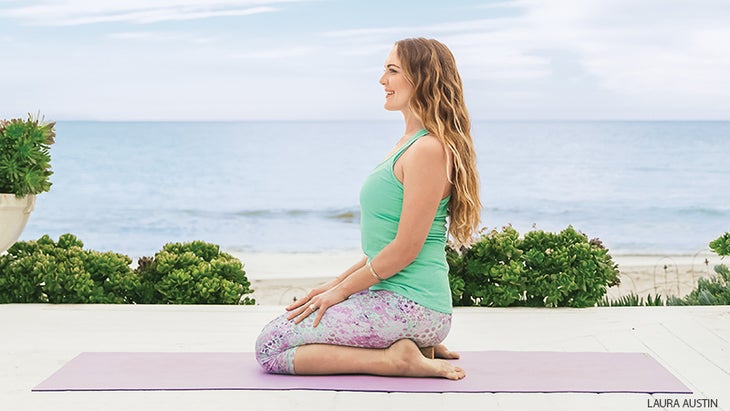
Virasana, with a block
Kneel and slide a block between your heels, so that the short edges of the block center on your ankles; sit back and press the tops of your feet and toenails evenly into the ground. Now sit tall, lengthening the crown of your head upward. Make sure the block evenly supports both sitting bones. Place your hands on your thighs or over your belly as you roll your shoulder heads back, then make your belly round with each full inhale. After a few breaths, start to cultivate Ujjayi Pranayama (Victorious Breath) by sweeping your breath along the back of your throat as you inhale and exhale through the nose. Stay here for 2 to 3 minutes. By beginning in this posture, you set a grounding tone for your practice.
See also 5 Yoga Tricks to Smooth Out Stressful Relationships
Hip circles

From Virasana, walk your hands forward into Tabletop, with your knees under your hips, and your wrists under your shoulders. Make small circles with your hips, warming up the spine and inviting a sense of fluidity. As you grow warmer, you can expand your circles, to the point of melting all the way back into Balasana (Child’s Pose) for a few breaths. Spend at least 1 minute circling in each direction. When you are done, lift your hips back into Adho Mukha Svanasana (Downward-Facing Dog Pose).
See also5 Common Myths About Athletes’ Tight Hips
Low Lunge
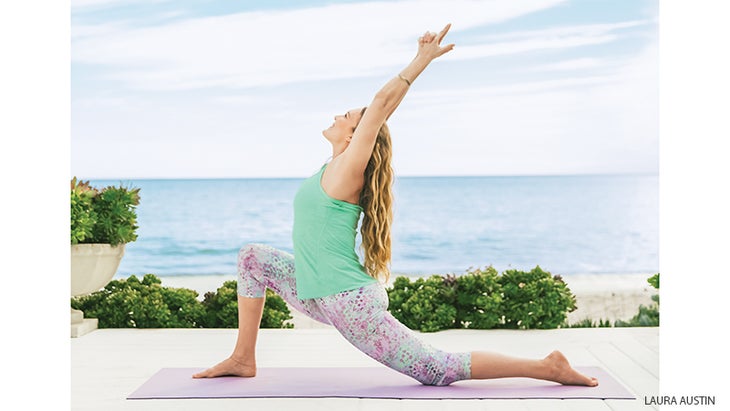
Anjaneyasana
From Down Dog, step your right foot toward your right thumb tip and set your back knee on the mat. Press the top of your foot firmly into the mat as you lengthen your tailbone toward your mat and draw your low belly in. Make sure your front knee doesn’t drift past your front ankle. Extend your arms alongside your ears. Interlace all but your index fingers, and press up through your palms, drawing your shoulders away from your ears. Bring your drishti, or gaze, up as you lift from your sternum and breathe underneath your collarbones. Firmly draw your hips in toward your midline as you grow tall through the sides of your waist and up through your index fingers. Hold for 1 minute.
See alsoAnatomy 101: Understand Your Hips to Build Stability
Half Monkey god Pose, a.k.a. Half Splits

Ardha Hanumanasana
From Low Lunge, lower your hands to either side of your right foot and shift back, straightening your right leg and flexing your right foot. Lengthen your heart forward on the inhale and fold on the exhale; if you feel your lower back rounding during this action, slide blocks underneath your palms or tent your fingertips. Move with the breath, playing with a wavelike movement of the upper body for 10 to 12 breaths. Then exhale to press back to Down Dog, and take Low Lunge and Half Splits on the left side. Finish in Down Dog.
See also4 Poses to Deepen Intimacy and Strengthen Relationships
Goddess Pose
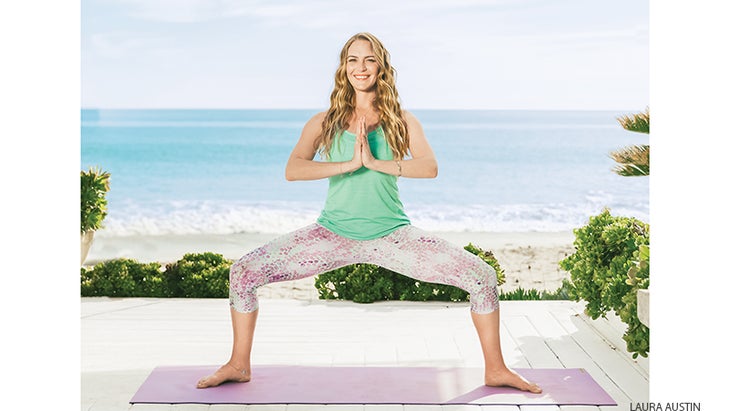
Utkata Konasana
From Down Dog, come to standing and bring your feet one leg’s distance apart; spin your legs and toes out about 45 degrees. Bend your knees deeply to create a 90-degree angle between your quads and shins, and press your knees open so that they align directly with the center of your feet. Draw your low belly in and your tailbone down. Position your torso right over your pelvis as you reach the crown of your head toward the sky. Place your palms together at your heart in Anjali Mudra (Salutation Seal). Try to hold this posture for 1 minute; while you breathe here, find organic movement as you shift slightly from side to side, or even forward and back, grounding through your heels and toes.
See alsoKino MacGregor’s Love-Your-Hips Gratitude Practice
Warrior Pose II
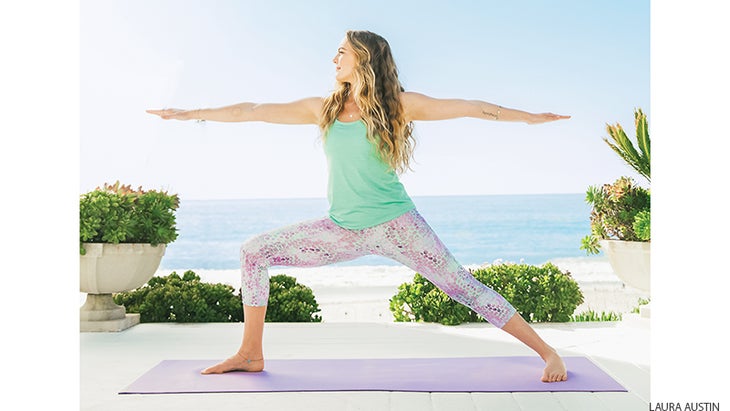
Virabhadrasana II
From Goddess, turn your hips to the right as you spin your back heel and plant it flat on the mat, parallel to the short edge of your mat or with left toes turned in just slightly. Line up your front heel with the arch of your back foot. Extend evenly through both arms and hands. Direct your gaze over your right middle finger. Move your right knee directly over your right ankle, aligning your knee in the direction of your second and third toes. Breathe for 6 to 8 full cycles. As you lunge forward in this powerful standing posture, remain receptive to all that’s occurring within you. Allow sensations, thoughts, and emotions to move through you with ease by simply reminding yourself that each experience is impermanent.
See also Open Hips + Shoulders for Pigeon Pose (Kapotasana)
Reverse Warrior Pose
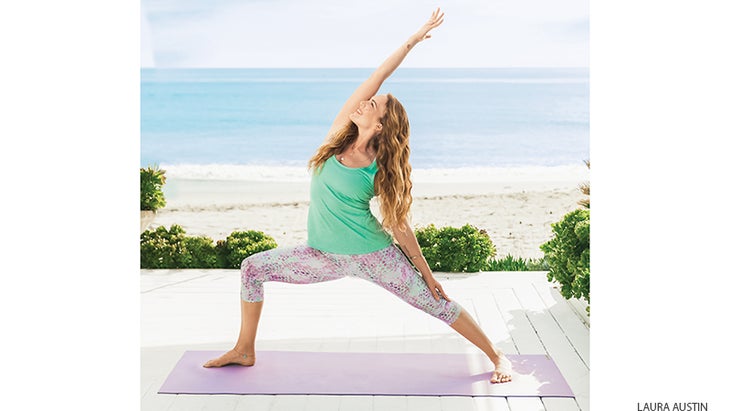
Viparita Virabhadrasana
Keep your legs just as they are in Warrior II, but flip your right palm up and begin to stretch back, reversing your Warrior as you slide your left hand down your back leg. Open into a deep sidebend. Aim for a 90-degree angle between your right shin and quad, working your thigh toward parallel with your mat. At the same time, create a softer shape through your upper body. Let go of the idea that this needs to a be a “perfect” posture and instead feel into the shape, making any needed intuitive or creative adjustments. Hold for 6 to 8 breaths. Come back to Goddess, then repeat Warrior II and Reverse Warrior on the left side. Finish in Goddess.
See alsoA Sequence to Stretch + Strengthen Outer Thighs and Hips
Wide-Legged standing Forward Bend C
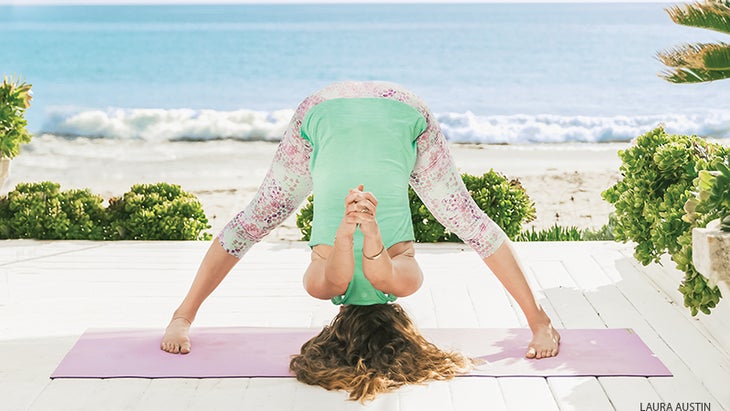
Prasarita Padottanasana C
From Goddess Pose, straighten your legs and turn your toes forward; interlace the fingers behind your back. Press down firmly through the fronts of your heels and lift your kneecaps, firming your thighs as you slowly fold forward and maybe bring the crown of your head to the floor. Shift your weight slightly forward, aligning your hips over your heels. As you open your hips, think about engaging and lifting the pelvic floor, finding balance in your second chakra between maintaining structure and letting go. Stay here using Ujjayi breath for 1 minute. When you’re done, pivot on your feet, coming into Low Lunge with your right foot forward; step back to Down Dog.
See alsoOpen Your Hips in Pigeon Pose (Eka Pada Rajakapotasana)
Frog Pose
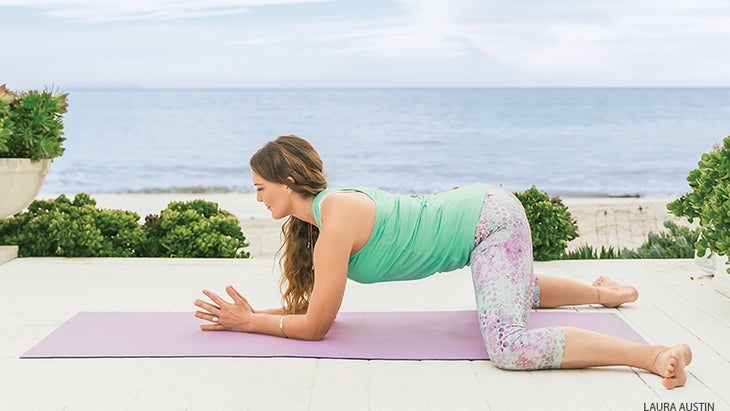
Mandukasana
From Down Dog, come to Tabletop, then begin to move your knees away from one another. As you do, make sure your feet stay in line with your knees, so that your shins and quads form a 90-degree angle. Flex your feet and press through your heels to protect your knees. Slide down to your forearms with your palms together and begin to gradually press your hips back toward your heels. Feel free to use a blanket underneath your knees for comfort. Stay for 1 minute, breathing deeply. Then press back to Child’s Pose for 1 minute before rolling up to seated. This intense hip-opening posture can often stir up emotions, so be extra generous with your breath, using it as a tool to ground you by drawing out your exhales a count or two longer than your inhales.
See alsoSkillful Sequencing: Plan a Chakra-Balancing Yoga Class
Seated Forward Bend
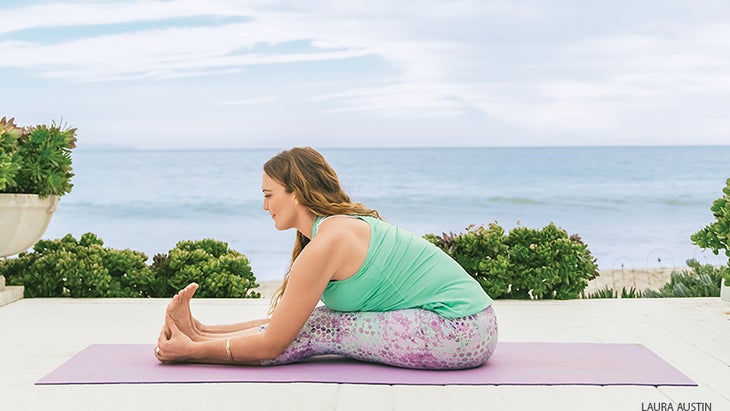
Paschimottanasana
Sit with your legs extended and rock side to side, rooting through your sitting bones. Stretch your arms upward, palms facing each other. Use your full inhale to lengthen your fingertips upward and create more space through your torso, and then use your full exhale to fold forward. Catch the outer edges of your feet or calves with your hands and lengthen your spine. Inhale to actively firm your legs, flex your feet, and draw your torso forward; exhale through the mouth to relax your arms alongside your legs and round forward with a soft bend to your knees. Take 6 to 8 cycles of breath. After so much hip opening, enjoy this deep, grounding stretch through your hamstrings, flexing your toes back to feel into your calves and Achilles. Inhale to roll up slowly.
See alsoModify Baddha Konasana + Align Your Sacral Chakra
Reclining Bound Angle Pose

Supta Baddha Konasana
Make your way onto your back. Bend your knees and bring the soles of your feet together. Let you knees release toward the floor, placing a block under each knee for support. Place your palms on your belly. As you close your eyes, slow your breath and give yourself these last couple of minutes to relax and feel the effort of your practice. Infuse your breath with a sense of intention, feeling into the spaciousness you’ve cultivated in your hips. Meditate on how you can step off your mat and approach your day with creative energy and an open mind.
See also Chakra Tune-Up: Intro to the Sahasrara

About our contributors
Teacher and model Mary Beth LaRue is a Los Angeles–based yoga instructor and life-design coach. She loves riding her bike, scribbling ideas over coffee, and taking long road trips with her family (including her English bulldog, Rosy). Inspired by her teachers Schuyler Grant, Elena Brower, and Kia Miller, LaRue has been teaching yoga for more than eight years, helping others connect to their inner bliss. She co-founded Rock Your Bliss, a yoga-inspired coaching company that helps clients “make shift happen.” Learn more at marybethlarue.com.
Writer Christine Chen is the author of Happy-Go-Yoga: Simple Poses to Relieve Pain, Reduce Stress, and Add Joy and a teacher at Laughing Lotus Yoga Center in New York City. She has studied with Cyndi Lee and Dana Flynn. Learn more at christinechenyoga.com.